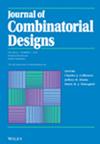求助PDF
{"title":"新的无限类2-色Steiner四元系统","authors":"Lijun Ji, Shuangqing Liu, Ye Yang","doi":"10.1002/jcd.21845","DOIUrl":null,"url":null,"abstract":"<p>In 1971, Doyen and Vandensavel gave a special doubling construction that gives a direct construction of 2-chromatic Steiner quadruple system of order <math>\n <semantics>\n <mrow>\n <mi>v</mi>\n </mrow>\n <annotation> $v$</annotation>\n </semantics></math> (SQS<math>\n <semantics>\n <mrow>\n \n <mrow>\n <mo>(</mo>\n \n <mi>v</mi>\n \n <mo>)</mo>\n </mrow>\n </mrow>\n <annotation> $(v)$</annotation>\n </semantics></math>) for all <math>\n <semantics>\n <mrow>\n <mi>v</mi>\n \n <mo>≡</mo>\n \n <mn>4</mn>\n </mrow>\n <annotation> $v\\equiv 4$</annotation>\n </semantics></math> or <math>\n <semantics>\n <mrow>\n <mn>8</mn>\n <mspace></mspace>\n \n <mrow>\n <mo>(</mo>\n \n <mrow>\n <mi>mod</mi>\n <mspace></mspace>\n \n <mn>12</mn>\n </mrow>\n \n <mo>)</mo>\n </mrow>\n </mrow>\n <annotation> $8\\,(\\mathrm{mod}\\,12)$</annotation>\n </semantics></math>. The first author presented a construction for 2-chromatic SQSs based on 2-chromatic candelabra quadruple systems and <math>\n <semantics>\n <mrow>\n \n <mi>s</mi>\n </mrow>\n <annotation> $s$</annotation>\n </semantics></math>-fan designs. In this paper, it is proved that a 2-chromatic SQS<math>\n <semantics>\n <mrow>\n <mrow>\n <mo>(</mo>\n \n <mi>v</mi>\n \n <mo>)</mo>\n </mrow>\n </mrow>\n <annotation> $(v)$</annotation>\n </semantics></math> also exists if <math>\n <semantics>\n <mrow>\n \n <mrow>\n <mi>v</mi>\n \n <mo>≡</mo>\n \n <mn>10</mn>\n <mspace></mspace>\n \n <mrow>\n <mo>(</mo>\n \n <mrow>\n <mi>mod</mi>\n <mspace></mspace>\n \n <mn>12</mn>\n </mrow>\n \n <mo>)</mo>\n </mrow>\n </mrow>\n </mrow>\n <annotation> $v\\equiv 10\\,(\\mathrm{mod}\\,12)$</annotation>\n </semantics></math>, or if <math>\n <semantics>\n <mrow>\n \n <mrow>\n <mi>v</mi>\n \n <mo>≡</mo>\n \n <mn>2</mn>\n <mspace></mspace>\n \n <mrow>\n <mo>(</mo>\n \n <mrow>\n <mi>mod</mi>\n <mspace></mspace>\n \n <mn>24</mn>\n </mrow>\n \n <mo>)</mo>\n </mrow>\n </mrow>\n </mrow>\n <annotation> $v\\equiv 2\\,(\\mathrm{mod}\\,24)$</annotation>\n </semantics></math>.</p>","PeriodicalId":15389,"journal":{"name":"Journal of Combinatorial Designs","volume":"30 9","pages":"613-620"},"PeriodicalIF":0.5000,"publicationDate":"2022-05-19","publicationTypes":"Journal Article","fieldsOfStudy":null,"isOpenAccess":false,"openAccessPdf":"","citationCount":"0","resultStr":"{\"title\":\"New infinite classes of 2-chromatic Steiner quadruple systems\",\"authors\":\"Lijun Ji, Shuangqing Liu, Ye Yang\",\"doi\":\"10.1002/jcd.21845\",\"DOIUrl\":null,\"url\":null,\"abstract\":\"<p>In 1971, Doyen and Vandensavel gave a special doubling construction that gives a direct construction of 2-chromatic Steiner quadruple system of order <math>\\n <semantics>\\n <mrow>\\n <mi>v</mi>\\n </mrow>\\n <annotation> $v$</annotation>\\n </semantics></math> (SQS<math>\\n <semantics>\\n <mrow>\\n \\n <mrow>\\n <mo>(</mo>\\n \\n <mi>v</mi>\\n \\n <mo>)</mo>\\n </mrow>\\n </mrow>\\n <annotation> $(v)$</annotation>\\n </semantics></math>) for all <math>\\n <semantics>\\n <mrow>\\n <mi>v</mi>\\n \\n <mo>≡</mo>\\n \\n <mn>4</mn>\\n </mrow>\\n <annotation> $v\\\\equiv 4$</annotation>\\n </semantics></math> or <math>\\n <semantics>\\n <mrow>\\n <mn>8</mn>\\n <mspace></mspace>\\n \\n <mrow>\\n <mo>(</mo>\\n \\n <mrow>\\n <mi>mod</mi>\\n <mspace></mspace>\\n \\n <mn>12</mn>\\n </mrow>\\n \\n <mo>)</mo>\\n </mrow>\\n </mrow>\\n <annotation> $8\\\\,(\\\\mathrm{mod}\\\\,12)$</annotation>\\n </semantics></math>. The first author presented a construction for 2-chromatic SQSs based on 2-chromatic candelabra quadruple systems and <math>\\n <semantics>\\n <mrow>\\n \\n <mi>s</mi>\\n </mrow>\\n <annotation> $s$</annotation>\\n </semantics></math>-fan designs. In this paper, it is proved that a 2-chromatic SQS<math>\\n <semantics>\\n <mrow>\\n <mrow>\\n <mo>(</mo>\\n \\n <mi>v</mi>\\n \\n <mo>)</mo>\\n </mrow>\\n </mrow>\\n <annotation> $(v)$</annotation>\\n </semantics></math> also exists if <math>\\n <semantics>\\n <mrow>\\n \\n <mrow>\\n <mi>v</mi>\\n \\n <mo>≡</mo>\\n \\n <mn>10</mn>\\n <mspace></mspace>\\n \\n <mrow>\\n <mo>(</mo>\\n \\n <mrow>\\n <mi>mod</mi>\\n <mspace></mspace>\\n \\n <mn>12</mn>\\n </mrow>\\n \\n <mo>)</mo>\\n </mrow>\\n </mrow>\\n </mrow>\\n <annotation> $v\\\\equiv 10\\\\,(\\\\mathrm{mod}\\\\,12)$</annotation>\\n </semantics></math>, or if <math>\\n <semantics>\\n <mrow>\\n \\n <mrow>\\n <mi>v</mi>\\n \\n <mo>≡</mo>\\n \\n <mn>2</mn>\\n <mspace></mspace>\\n \\n <mrow>\\n <mo>(</mo>\\n \\n <mrow>\\n <mi>mod</mi>\\n <mspace></mspace>\\n \\n <mn>24</mn>\\n </mrow>\\n \\n <mo>)</mo>\\n </mrow>\\n </mrow>\\n </mrow>\\n <annotation> $v\\\\equiv 2\\\\,(\\\\mathrm{mod}\\\\,24)$</annotation>\\n </semantics></math>.</p>\",\"PeriodicalId\":15389,\"journal\":{\"name\":\"Journal of Combinatorial Designs\",\"volume\":\"30 9\",\"pages\":\"613-620\"},\"PeriodicalIF\":0.5000,\"publicationDate\":\"2022-05-19\",\"publicationTypes\":\"Journal Article\",\"fieldsOfStudy\":null,\"isOpenAccess\":false,\"openAccessPdf\":\"\",\"citationCount\":\"0\",\"resultStr\":null,\"platform\":\"Semanticscholar\",\"paperid\":null,\"PeriodicalName\":\"Journal of Combinatorial Designs\",\"FirstCategoryId\":\"100\",\"ListUrlMain\":\"https://onlinelibrary.wiley.com/doi/10.1002/jcd.21845\",\"RegionNum\":4,\"RegionCategory\":\"数学\",\"ArticlePicture\":[],\"TitleCN\":null,\"AbstractTextCN\":null,\"PMCID\":null,\"EPubDate\":\"\",\"PubModel\":\"\",\"JCR\":\"Q3\",\"JCRName\":\"MATHEMATICS\",\"Score\":null,\"Total\":0}","platform":"Semanticscholar","paperid":null,"PeriodicalName":"Journal of Combinatorial Designs","FirstCategoryId":"100","ListUrlMain":"https://onlinelibrary.wiley.com/doi/10.1002/jcd.21845","RegionNum":4,"RegionCategory":"数学","ArticlePicture":[],"TitleCN":null,"AbstractTextCN":null,"PMCID":null,"EPubDate":"","PubModel":"","JCR":"Q3","JCRName":"MATHEMATICS","Score":null,"Total":0}
引用次数: 0
引用
批量引用

 求助内容:
求助内容: 应助结果提醒方式:
应助结果提醒方式:


